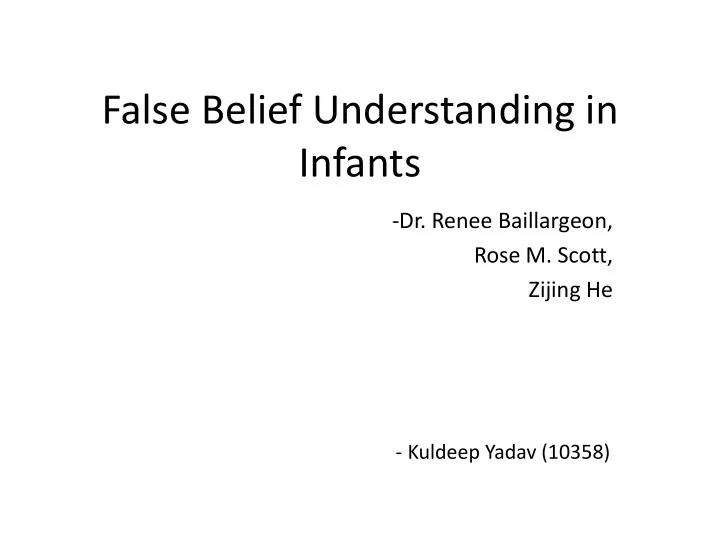

False Belief Understanding in Infants -Dr. Renee Baillargeon, Rose M. Scott, Zijing He - Kuldeep Yadav (10358)
Let’s start with a situation
If this question is asked to you You will answer – Box A If I ask this same question to the children • Age (around 4 years) – they will answer Box A (where Kuldeep falsely believe the ball is) • Age (below 4 years) – mostly will answer Box B (where the ball actually is) This shows that children below 4 years of age do not understand that Kuldeep will have a false belief. This process of directly questioning to the children about false belief of agents is called elicited response tasks.
Here Dr, Baillargeon is practicing spontaneous response tasks and showing that false belief understanding in infants present much earlier than what is being suggested by elicited response task. Spontaneous response tasks includes Violation of Expectation (VOE) task in which an infant looks reliably longer when agents violates the expectation of the infant. To date, spontaneous response tasks Have shown that infants can attribute an agent • False belief about an objects location • False perception of an object • False belief about an object’s identity
False belief about location (15 months old infants) Familiarization of the experiment to infant, every time agent hide the toy in green box and put his hand in green box in order to grasp it. Here in the absence of the agent the toy is being transferred to the yellow box When agent search for the toy in yellow box, infants looks reliably longer to it as they expected the agent to look in green box.
Here in the presence of the agent the toy is being transferred to the yellow box Then again here in the absence of the agent the toy is being transferred to the yellow box When agent search for the toy in green box, infants looks reliably longer to it suggesting that infants expected the agent to falsely believe that toy is in yellow box. This shows that even 15 months old infants can attribute false belief to agents about location
False perception of an object (14.5 months old infants) Doll Condition: The agent always reached for doll when both doll and skunk are placed before her. Skunk Condition: The agent always reached for skunk when both doll and skunk are placed before her.
the right box’s lid had a tuft of blue hair (similar to the doll’s) attached to it In the absence of agent the experimenter hide the doll in the plain box and the skunk in the hair box The infants expected the agent: • To falsely perceive the tuft of hair as belonging to the doll • To falsely conclude that the doll was hidden in the hair box and the skunk in the plain box • To search for her preferred toy accordingly.
False belief of an object’s identity (18 months old infants)
In the absence of agent the experimenter assembled the 2-piece penguin, covered it with a transparent cover, and then covered the 1- piece penguin with an opaque cover. The infants looked reliably longer when the agent reached for the transparent as opposed to the opaque cover, suggesting that they expected agent: • To falsely assume that the penguin under the transparent cover was the 1-piece penguin • To falsely conclude that the disassembled 2-piece penguin was under the opaque cover (because both penguins were always present in the familiarization trials) • To reach for the opaque cover
Why do young children fail at elicited-response false-belief tasks? According to our response account, elicited-response tasks involve at least three processes: • A false belief representation process (children must represent the agent’s false belief) • A response-selection process (when asked the test question, children must access their representation of the agent’s false belief to select a response ) • A response-inhibition process (when selecting a response, children must inhibit any prepotent tendency to answer the test question based on their own knowledge) On the other hand Spontaneous response tasks only involve the false belief representation process. Young children fail elicited response tasks because simultaneously executing the false belief representation, response selection, and response inhibition processes overwhelms their limited resources, and/or because the connections between the brain regions that serve these processes are still inefficient.
Summary The evidence reviewed above suggests that infants in the second year of life can already attribute false beliefs to others Infants can attribute an agent • False belief about an objects location (15 months olds) • False perception of an object (14.5 months olds) • False belief about an object’s identity (18 month olds)
References Renee Baillargeon, Rose M. Scott and Zijing He “False -belief understanding in infants”, Department of Psychology, University of Illinois, Champaign, IL 61820, USA Wimmer & Perner , “Modeling the False -Belief Task ”, 1983 https://www.youtube.com/watch?v=Zd7OIDm_btM
Recommend
More recommend